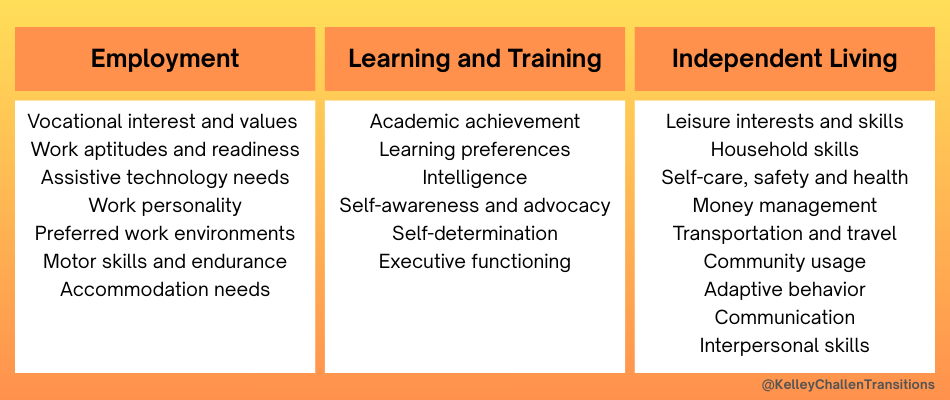How Do You Know if Transition Assessment Is Comprehensive?
Not all assessments are created equal. Here’s what to look for when evaluating whether a student’s transition assessment will actually prepare them for life after high school.
For students, families, and even educators navigating the IEP process, the term “transition assessment” may feel either like a mystery or just another checkbox on a long to-do list. They might wonder: What does it actually mean? When is it supposed to happen? And how do we know if the assessment was any good?
Over the past month, I have shared articles describing transition planning and assessment and outlining when this process needs to begin. But in case you are new to my Substack, let’s start with a key point:
Transition assessment is not a one-time event—it’s an ongoing process.
What Is Transition Assessment, Really?
Before I discuss what makes a transition assessment comprehensive, it’s important to understand what transition assessment is designed to do.
Transition assessment is the process of gathering information to help a student with a disability plan for life after high school. This includes planning for employment, postsecondary education and/or training, and independent living, including participation in the community.
The information collected should both guide the student’s postsecondary goals (i.e., long-term goals for after high school) and the transition services needed in the IEP. Transition assessment can involve:
Formal assessments (e.g., standardized tests, inventories, rating scales, aptitude measures)
Informal tools (e.g., interviews, observations, qualitative worksheets, situational assessments)
Input from multiple sources (student, family, educators, and related service providers)
At its best, transition assessment provides a detailed, individualized picture of who the student is, their strengths, preferences, interests, needs, and goals—along with what instruction and supports they’ll need to progress toward those goals.
Key Questions for Evaluating Comprehensiveness
1. Does it sound like the student?
This is one of the simplest—and most powerful—questions you can ask.
When you read the report, does it reflect the student’s personality, preferences, strengths, and challenges? Or does it feel generic, like a copy-and-paste description that could apply to any student?
A strong assessment should:
Clearly describe the student as an individual.
Include their voice—ideally through direct quotes or a thoughtful summary of their responses.
Incorporate the voices of people who know the student well.
You should be able to hear and recognize the student in the report.
2. Were both formal and informal tools used?
Transition assessment isn’t just about administering a few tests. A comprehensive approach blends formal tools with informal measures, such as interviews, observations, and real-life work samples or simulations. Formal tools provide structure and comparison points and can be especially helpful for identifying general areas of vulnerability. Informal tools provide context and depth and often help to identify specific starting points for skill development.
3. Was data gathered from multiple sources?
A meaningful assessment includes more than just student input. While the student’s voice must be central, a comprehensive picture also incorporates perspectives from parents and caregivers, teachers and school staff, and even related providers and community providers who know the student well. Each of these people sees the student through a different lens, helping create a more complete view of the student’s functioning across activities and settings.
4. Were different environments considered?
It’s not enough to assess how a student performs in a quiet testing room or a single classroom. Transition planning is about preparing students for the real world—so assessments should consider performance in multiple settings, including home, school, community, social situations, and job sites or volunteer settings. At some point before exiting public education, assessments should occur in environments that resemble actual postsecondary learning, training, employment, living, and community environments.
5. Were all areas of transition considered?
Comprehensive assessment doesn’t mean everything has to be tested at once, but the key areas should be acknowledged and explored over time. These include:
Employment
Postsecondary education and/or training
Independent living, including community engagement
To address these areas comprehensively, it may be important to consider the following:
Keep in mind that many of these items affect multiple domains of transition planning. For example, executive functioning and self-determination are critical across employment, learning, and independent living.
Additional Features of High-Quality Assessment
In addition to the five questions above, strong transition assessments often include:
A detailed record review
A transition planning inventory or checklist
Clear descriptions of support needs or levels of independence
Evidence of functional performance—not just knowledge or intent
Clear recommendations aligned with the student’s goals
Enough information to meaningfully inform all relevant IEP sections
Common Misunderstandings
It’s not unusual for families, or even school teams, to assume that if a student has had a three-year reevaluation, transition assessment has been 'done.' While those evaluations provide critical data, they often don’t address readiness for work, life skills and community participation, postsecondary learning or training needs, and real-world functioning. Without targeted transition assessment, critical areas may be overlooked.
A Note for Professionals
If you’re a transition specialist, school psychologist, educator, or related provider, it’s worth asking:
Is the transition assessment we are conducting truly comprehensive—or just a checkbox for compliance?
The best assessments are collaborative, student-centered, practical, and anchored in the student’s long-term vision.
Final Thoughts
Comprehensive transition assessment should empower the student, and their team, to prioritize, plan, and take next steps forward. It should reflect who the student is, who they want to be, what they need, and how to get there—not just for this year, but well beyond high school.







